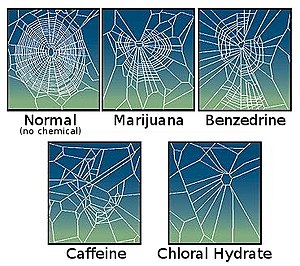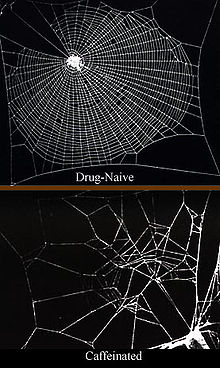
Effect of psychoactive drugs on animals

Psychoactive drugs, such as alcohol, caffeine, amphetamine, mescaline, lysergic acid diethylamide (LSD), cannabis, chloral hydrate, theophylline, IBMX and others, have been studied on certain animals. It is believed that plants developed caffeine as a chemical defense against insects.[1]

Consumption by wild animals in nature
Species that have been reported to consume alcohol in the wild include Bohemian waxwings, fruit bats, tree shrews, and bees, though there is no evidence that these species consume alcohol preferentially.[2] Anecdotal reports of drunken animals in the wild include moose, parrots, orangutans, and a badger.[3]

Birds
Cedar waxwing, bohemian waxwing, common starling are frequently studied species when examining the effects of alcohol consumption in birds.[4]

Cedar waxwings have been observed flying while intoxicated by alcohol from overwintered hawthorn pommes ("haws"), resulting in crashes that lead to their deaths.[5]

Mammals
Chimpanzees
Wild chimpanzees in Bossou, Guinea, have been observed consuming fermented sap from the raffia palm (Raphia hookeri) from 1995 to 2012. They use simple tools to access the sap, which averages 3.1% ABV. This behavior suggests that ethanol does not deter feeding and indicates that the last common ancestor of African apes and humans likely consumed foods containing ethanol.[6]

Chimpanzees at Bossou consumed large amounts of ethanol and showed signs of intoxication. Although detailed behavioral data before and after drinking was rarely collected, some chimps rested right after consuming fermented sap.[6]

Animal testing
Invertebrates
Fruit flies
Ethanol serves as an energy source for the common fruit fly.[7]

A study on fruit flies (Drosophila melanogaster) found that male flies become more aggressive when exposed to ethanol-containing food sources. This increased aggression is linked to the odor of ethanol, which enhances sensory neuron activity related to aggression-promoting pheromones and boosts attraction to citrus scents. These findings provide insights into how fruit flies interact with their environment.[8]

In a study using D. melanogaster, researchers found that mating increases neuropeptide F (NPF) levels in male flies, while sexual deprivation decreases them. Manipulating the NPF system affects ethanol preference: activation reduces preference, and inhibition enhances it. Notably, artificially activating NPF neurons is rewarding on its own and diminishes the reward effect of ethanol. These findings suggest that the NPF-NPF receptor axis reflects the state of the fly's reward system and influences behavior.[9]

Oriental hornets
Ethanol is nutritious but highly intoxicating for most animals, which typically tolerate only up to 4% in their diet. However, a 2024 study found that oriental hornets fed sugary solutions containing 1% to 80% ethanol for a week showed no adverse effects on behavior or lifespan.[10]

Spiders


In 1948, Swiss pharmacologist Peter N. Witt started his research on the effect of drugs on spiders. The initial motivation for the study was a request from his colleague, zoologist H. M. Peters, to shift the time when garden spiders build their webs from between 2:00 a.m. and 5:00 a.m., which was decidedly inconvenient for Peters, to earlier hours.[13] Witt tested spiders with a range of psychoactive drugs, including amphetamine, mescaline, strychnine, LSD, and caffeine, and found that the drugs affect the size and shape of the web rather than the time when it is built. At small doses of caffeine (10 μg/spider), the webs were smaller; the radii were uneven, but the regularity of the circles was unaffected. At higher doses (100 μg/spider), the shape changed more, and the web design became irregular. All the drugs tested reduced web regularity except for small doses (0.1–0.3 μg) of LSD, which increased web regularity.[12]

The drugs were administered by dissolving them in sugar water, and a drop of solution was touched to the spider's mouth. In some later studies, spiders were fed with drugged flies.[14] For qualitative studies, a well-defined volume of solution was administered through a fine syringe. The webs were photographed for the same spider before and after drugging.[12]

Witt's research was discontinued, but it became reinvigorated in 1984 after a paper by J.A. Nathanson in the journal Science,[15] which is discussed below. In 1995, a NASA research group repeated Witt's experiments on the effect of caffeine, benzedrine, marijuana and chloral hydrate on European garden spiders. NASA's results were qualitatively similar to those of Witt, but the novelty was that the pattern of the spider web was quantitatively analyzed with modern statistical tools, and proposed as a sensitive method of drug detection.[11][16]

Other arthropods and molluscs
In 1984, Nathanson reported an effect of methylxanthines on larvae of the tobacco hornworm. He administered solutions of finely powdered tea leaves or coffee beans to the larvae and observed, at concentrations between 0.3 and 10% for coffee and 0.1 to 3% for tea, inhibition of feeding, associated with hyperactivity and tremor. At higher concentrations, larvae were killed within 24 hours. He repeated the experiments with purified caffeine and concluded that the drug was responsible for the effect, and the concentration differences between coffee beans and tea leaves originated from 2–3 times higher caffeine content in the latter. Similar action was observed for IBMX on mosquito larvae, mealworm larvae, butterfly larvae and milkweed bug nymphs, that is, inhibition of feeding and death at higher doses. Flour beetles were unaffected by IBMX up to 3% concentrations, but long-term experiments revealed suppression of reproductive activity.[15]

Further, Nathanson fed tobacco hornworm larvae with leaves sprayed with such psychoactive drugs as caffeine, formamidine pesticide didemethylchlordimeform (DDCDM), IBMX or theophylline. He observed a similar effect, namely inhibition of feeding followed by death. Nathanson concluded that caffeine and related methylxanthines could be natural pesticides developed by plants as protection against worms: Caffeine is found in many plant species, with high levels in seedlings that are still developing foliage, but are lacking mechanical protection;[17] caffeine paralyzes and kills certain insects feeding upon the plant.[15] High caffeine levels have also been found in the soil surrounding coffee bean seedlings. It is therefore understood that caffeine has a natural function, both as a Biopesticide and as an inhibitor of seed germination of other nearby coffee seedlings, thus giving it a better chance of survival.[18]

Coffee berry borers seem to be unaffected by caffeine, in that their feeding rate did not change when they were given leaves sprayed with caffeine solution. It was concluded that those beetles have adapted to caffeine.[19] This study was further developed by changing the solvent for caffeine. Although aqueous caffeine solutions had indeed no effect on the beetles, oleate emulsions of caffeine did inhibit their feeding, suggesting that even if certain insects have adjusted to some caffeine forms, they can be tricked by changing minor details, such as the drug solvent.[20]

These results and conclusions were confirmed by a similar study on slugs and snails. Cabbage leaves were sprayed with caffeine solutions and fed to Veronicella cubensis slugs and Zonitoides arboreus snails. Cabbage consumption reduced over time, followed by the death of the molluscs.[21] Inhibition of feeding by caffeine was also observed for caterpillars.[22]

Mammals
Elephants
"Tusko" was the name of a male Indian elephant at the Oklahoma City Zoo. On August 3, 1962,[23] researchers from the University of Oklahoma injected (human use involves oral ingestion) 297 mg of LSD to him, which is nearly three thousand times the human recreational dose (for an animal weighing roughly one hundred times as much as a human).[note 1] Within five minutes he collapsed to the ground and one hour and forty minutes later he died. It is believed that the LSD was the cause of his death, although some speculate that the drugs the researchers used in an attempt to revive him may have contributed to his death.[24][25][26][27][28][29] In 1984 psychologist Ronald K. Siegel repeated the experiment with two elephants, using LSD only. Both survived.[29]

Dolphins
Bottlenose dolphins were administered LSD in the 1960s as part of NASA-funded experiments by John C. Lilly to study human–animal communication. The drug caused the animals to become more vocal, but did not enable meaningful communication.[30][31][32]

Macaque monkeys
Macaque monkeys administered with the antipsychotics haloperidol and olanzapine over a 17–27 month period showed reduced brain volume. These results have not been observed in humans who also take the drug, due to the lack of available data.[33]

Squirrel monkeys
In a scientific study, researchers looked at how different drugs are self-administered by squirrel monkeys. The drugs they studied included cocaine and a few others that have some similarities to cocaine in how they affect the brain.

They trained the monkeys to give themselves these drugs through injections and observed their behavior. They wanted to see if the drugs had similar effects on the monkeys.

The results showed that cocaine and some of the other drugs had similar effects in maintaining the monkeys' self-administration behavior. However, one of the drugs, mazindol, didn't have the same effect on all the monkeys.

This suggests that the drugs that had similar effects may work in similar ways in the brain, affecting the monkeys' behavior in a comparable manner. The study also indicated that the reinforcing (addictive) and stimulating effects of these drugs might be related to how they interact with specific areas in the brain.

Overall, the research provides insights into how these drugs affect behavior and their potential for addiction.[34]

The researchers used a resident-intruder model to simulate social stress, with a focus on how social rank influenced the effects. The results showed that the confrontation influenced the monkeys' response to cocaine. When subordinate monkeys acted as intruders, their self-administration of low-dose cocaine increased, and their dose-response curve shifted to the left. In contrast, dominant monkeys experienced a decrease in cocaine self-administration and a rightward shift in the dose-response curve.

Brain glucose metabolism measurements revealed differences between dominant and subordinate monkeys, shedding light on the underlying mechanisms of these opposing behavioral effects. Dominant monkeys showed higher activity in brain regions related to visual processing, attention, and vigilance, while subordinate monkeys exhibited higher activity in areas linked to emotional processing and anxiety.

Both groups showed increased brain activity in regions associated with the reward system and stress response. Dominant monkeys also displayed higher aggression during the confrontations, suggesting that the opportunity to aggress might serve as a reinforcer.

The study indicated that the social context strongly influences behavior and drug effects, offering insights into individual differences in drug self-administration. It emphasized the need to consider the influence of social factors when developing treatments for cocaine use disorders, tailoring interventions to individuals based on their responses to social and environmental stressors. Understanding the neural and behavioral mechanisms at play in these scenarios can lead to more effective, personalized treatments for individuals with cocaine use disorders.[35]

Fish
Zebrafish
Zebrafish have long acted as a model for humans to test the effects of various psychoactive substances. One study conducted by the Research Society on Alcoholism concluded that when given a moderate dose of ethanol, zebrafish became more active and swam faster. When the dose of alcohol increased, the zebrafish became sluggish. Another study by the same institute found that when a "drunk" (blood alcohol concentration of over 0.1) zebrafish is introduced to a group of sober ones, the sober fish will follow the drunk individual as their leader.[36]

In a study testing the effects of THC on memory in zebrafish, researchers found that THC impairs spatial memory but has no effect on associative memory. Zebrafish were able to remember color patterns associated with them getting fed after being put under the influence of THC, but were unable to remember the spatial pattern associated with them getting fed after being put under the influence of THC.[37]

Zebrafish have also been used to test the medicinal benefits of certain psychoactive drugs, particularly how they can be used to treat mental health problems.[38] A study looking into the antidepressant properties of ketamine using zebrafish as subjects found that when exposed to small amounts of ketamine (2 mg/L), zebrafish displayed more aggressive behavior. However, when the zebrafish were exposed to higher doses of ketamine (20 mg/L & 40 mg/L), their aggressive behavior subsided. Moreover, the highest dose of ketamine increased locomotion and circling behavior.[39] In another study testing the behavioral effects of LSD on zebrafish found that zebrafish that were exposed to the substance demonstrated increased inter-fish distance when shoaling, and had increased cortisol levels. These could show possible side effects of LSD if used as a therapeutic drug.[40]

Nile Tilapia
A study conducted by the Aquaculture Institute looked into the effects of cannabis oil on the metabolism and immune system of the Nile tilapia (Oreochromis niloticus). They found that cannabis has no measurable effect on the white blood cell count or plasma protein concentration, and therefore has no effect on the immune system of the Nile tilapia. However, the tilapia that were fed food pellets laced with THC demonstrated a higher food conversion rate. This higher food conversion rate lead researchers to believe that THC increases the metabolic rate of Nile tilapia.[41]

Further reading
- Siegel, Ronald K. (1989, 2005) Intoxication: The Universal Drive for Mind-Altering Substances
See also
Notes
- ^ Tusko's realistic, unexaggerated weight was probably around 14,000 lb (6,350 kg), whereas the world average for an adult human's weight (in early 2019) was 136.7 lb (62.0 kg).
References
- ^ Ashihara, Hiroshi; Crozier, Alan (2001-09-01). "Caffeine: a well known but little mentioned compound in plant science". Trends in Plant Science. 6 (9): 407–413. Bibcode:2001TPS.....6..407A. doi:10.1016/S1360-1385(01)02055-6. PMID 11544129.
- ^ Umer, Natasha (December 16, 2014). "9 Animals That Get Drunk Or High". BuzzFeed. Archived from the original on April 4, 2023. Retrieved March 22, 2023.
- ^ Cooke, Lucy (April 19, 2018). "Do moose (and other animals) eat fermented fruit to get drunk?". Big Think. Archived from the original on April 4, 2023. Retrieved April 4, 2023.
- ^ Tryjanowski, P; Hetman, M; Czechowski, P; Grzywaczewski, G; Sklenicka, P; Ziemblińska, K; Sparks, TH (9 February 2020). "Birds Drinking Alcohol: Species and Relationship with People. A Review of Information from Scientific Literature and Social Media". Animals. 10 (2): 270. doi:10.3390/ani10020270. PMC 7071081. PMID 32050472.
- ^ Fitzgerald, SD; Sullivan, JM; Everson, RJ (April 1990). "Suspected ethanol toxicosis in two wild cedar waxwings". Avian Diseases. 34 (2): 488–90. doi:10.2307/1591442. JSTOR 1591442. PMID 2369387.
- ^ a b Hockings, KJ; Bryson-Morrison, N; Carvalho, S; Fujisawa, M; Humle, T; McGrew, WC; Nakamura, M; Ohashi, G; Yamanashi, Y; Yamakoshi, G; Matsuzawa, T (June 2015). "Tools to tipple: ethanol ingestion by wild chimpanzees using leaf-sponges". Royal Society Open Science. 2 (6): 150150. Bibcode:2015RSOS....250150H. doi:10.1098/rsos.150150. PMC 4632552. PMID 26543588.
- ^ Pohl, J. B.; Baldwin, B. A.; Dinh, B. L.; Rahman, P.; Smerek, D.; Prado, F. J. III; Sherazee, N.; Atkinson, N. S. (2012). "Ethanol Preference in Drosophila melanogaster is Driven by Its Caloric Value". Alcoholism: Clinical and Experimental Research. 36 (11): 1903–1912. doi:10.1111/j.1530-0277.2012.01817.x. PMC 414655. PMID 22551215.
- ^ Park, A; Tran, T; Scheuermann, EA; Smith, DP; Atkinson, NS (3 November 2020). "Alcohol potentiates a pheromone signal in flies". eLife. 9. doi:10.7554/eLife.59853. PMC 7671682. PMID 33141025.
- ^ Shohat-Ophir, G; Kaun, KR; Azanchi, R; Mohammed, H; Heberlein, U (16 March 2012). "Sexual deprivation increases ethanol intake in Drosophila". Science. 335 (6074): 1351–5. Bibcode:2012Sci...335.1351S. doi:10.1126/science.1215932. PMC 3909676. PMID 22422983.
- ^ "Hornets can hold their alcohol like no other animal on Earth". New Scientist.
- ^ a b c Noever, David A.; Cronise, Raymond J.; Relwani, Rachna A. (1995). "Using spider-web patterns to determine toxicity" (PDF). NASA Tech Briefs. 19 (4): 82. Archived from the original (PDF) on 2021-03-27. Also published in New Scientist magazine Archived 2015-05-24 at the Wayback Machine, on 29 April 1995
- ^ a b c Foelix, Rainer F. (2010). Biology of spiders. Oxford University Press. p. 179. ISBN 978-0199813247. Archived from the original on 2022-01-28. Retrieved 2020-05-09.
- ^ Witt, Peter (December 1954). "Spider Webs and Drugs". Scientific American. 191 (6): 80–87. Bibcode:1954SciAm.191f..80W. doi:10.1038/scientificamerican1254-80. JSTOR 24943711.
- ^ Witt, Peter; Rovner, Jerome (1982). Spider Communication: Mechanisms and Ecological Significance. Princeton University Press. ISBN 978-0-691-08291-2.
- ^ a b c Nathanson, J. A. (1984). "Caffeine and related methylxanthines: possible naturally occurring pesticides". Science. 226 (4671): 184–7. Bibcode:1984Sci...226..184N. doi:10.1126/science.6207592. PMID 6207592.
- ^ Weinberg, Bennett Alan; Bealer, Bonnie K. (2001). The world of caffeine: the science and culture of the world's most popular drug. Routledge. pp. 237–239. ISBN 978-0-415-92723-9.
- ^ Frischknecht, P. M.; Urmer-Dufek J.; Baumann T.W. (1986). "Purine formation in buds and developing leaflets of Coffea arabica: expression of an optimal defence strategy?". Phytochemistry. 25 (3): 613–6. doi:10.1016/0031-9422(86)88009-8.
- ^ Baumann, T. W.; Gabriel H. (1984). "Metabolism and excretion of caffeine during germination of Coffea arabica L" (PDF). Plant and Cell Physiology. 25 (8): 1431–6. doi:10.1093/oxfordjournals.pcp.a076854. Archived (PDF) from the original on 2022-01-28. Retrieved 2019-12-07.
- ^ Guerreiro Filho, Oliveiro; Mazzafera, P (2003). "Caffeine and Resistance of Coffee to the Berry Borer Hypothenemus hampei (Coleoptera: Scolytidae)". Journal of Agricultural and Food Chemistry. 51 (24): 6987–91. Bibcode:2003JAFC...51.6987G. doi:10.1021/jf0347968. PMID 14611159.
- ^ Araque, Pedronel; Casanova, H; Ortiz, C; Henao, B; Pelaez, C (2007). "Insecticidal Activity of Caffeine Aqueous Solutions and Caffeine Oleate Emulsions against Drosophila melanogaster and Hypothenemus hampei". Journal of Agricultural and Food Chemistry. 55 (17): 6918–22. Bibcode:2007JAFC...55.6918A. doi:10.1021/jf071052b. PMID 17658827.
- ^ Hollingsworth, Robert G.; Armstrong, JW; Campbell, E (2002). "Pest Control: Caffeine as a repellent for slugs and snails". Nature. 417 (6892): 915–6. Bibcode:2002Natur.417..915H. doi:10.1038/417915a. PMID 12087394. S2CID 5441786. Archived from the original on 2022-04-15. Retrieved 2021-06-13.
- ^ JI Glendinning, NM Nelson and EA Bernays (2000). "How do inositol and glucose modulate feeding in Manduca sexta caterpillars?". Journal of Experimental Biology. 203 (8): 1299–315. doi:10.1242/jeb.203.8.1299. PMID 10729279.
- ^ West, L. J.; Pierce, C. M.; Thomas, W. D. (1962). "Lysergic Acid Diethylamide: Its Effects on a Male Asiatic Elephant" (PDF). Science. 138 (3545): 1100–1103. Bibcode:1962Sci...138.1100J. doi:10.1126/science.138.3545.1100. PMID 17772968. Archived from the original (PDF) on 2012-12-15.
- ^ LSD – My Problem Child (PDF). McGraw-Hill Book Company. 1976. p. 102. ISBN 0-07-029325-2. Archived (PDF) from the original on 2022-01-28. Retrieved 2020-01-20.
- ^ West, LJ; Pierce, CM; Thomas, WD (7 December 1962). "Lysergic Acid Diethylamide: Its Effects on a Male Asiatic Elephant". Science. 138 (3545): 1100–3. Bibcode:1962Sci...138.1100J. doi:10.1126/science.138.3545.1100. PMID 17772968.
- ^ Boese, A. (2007). Elephants on Acid: And Other Bizarre Experiments. Ch. 5 "Animal Tales". Harcourt. ISBN 0-15-603135-3
- ^ "Erowid LSD (Acid) Vault : LSD Related Death of Elephant in 1962". Erowid. November 30, 2012. Archived from the original on March 17, 2010. Retrieved March 30, 2010.
- ^ Jensen, Johan (7 August 2002). "A dose of madness". The Guardian. Archived from the original on 27 January 2008. Retrieved 19 January 2020.
- ^ a b Pilkington, Mark (26 February 2004). "Tusko's last trip". The Guardian. Archived from the original on 28 January 2022. Retrieved 20 January 2020.
- ^ "Scientists once gave dolphins LSD in attempt to communicate with them". The Independent. 13 June 2017. Archived from the original on 29 September 2021. Retrieved 1 November 2020.
- ^ Oberhaus, Daniel (2 March 2017). "What We've Learned from Giving Dolphins LSD". Vice. Archived from the original on 28 January 2022. Retrieved 1 November 2020.
- ^ Abramson, Harold Alexander (1967). The Use of LSD in Psychotherapy and Alcoholism. Bobbs-Merrill. pp. 47–52. Archived from the original on 2022-01-28. Retrieved 2020-11-05.
- ^ Dorph-Petersen, KA; Pierri, JN; Perel, JM; Sun, Z; Sampson, AR; Lewis, DA (September 2005). "The influence of chronic exposure to antipsychotic medications on brain size before and after tissue fixation: a comparison of haloperidol and olanzapine in macaque monkeys". Neuropsychopharmacology. 30 (9): 1649–61. doi:10.1038/sj.npp.1300710. PMID 15756305.
- ^ Bergman, J.; Madras, B. K.; Johnson, S. E.; Spealman, R. D. (October 1989). "Effects of cocaine and related drugs in nonhuman primates. III. Self-administration by squirrel monkeys". The Journal of Pharmacology and Experimental Therapeutics. 251 (1): 150–155. ISSN 0022-3565. PMID 2529365.
- ^ Gould, Robert W; Czoty, Paul W; Porrino, Linda J; Nader, Michael A (April 2017). "Social Status in Monkeys: Effects of Social Confrontation on Brain Function and Cocaine Self-Administration". Neuropsychopharmacology. 42 (5): 1093–1102. doi:10.1038/npp.2016.285. ISSN 0893-133X. PMC 5506801. PMID 28025974.
- ^ Ladu, Fabrizio; Butail, Sachit; Macrí, Simone; Porfiri, Maurizio (2014). "Sociality Modulates the Effects of Ethanol in Zebra Fish". Alcoholism: Clinical and Experimental Research. 38 (7): 2096–2104. doi:10.1111/acer.12432. PMID 24819037.
- ^ Ruhl, Tim; Prinz, Nicole; Oellers, Nadine; Seidel, Nathan Ian; Jonas, Annika; Albayram, Önder; Bilkei-Gorzo, Andras; von der Emde, Gerhard (2014). "Acute administration of THC impairs spatial but not associative memory function in zebrafish". Psychopharmacology. 231 (19): 3829–3842. doi:10.1007/s00213-014-3522-5. PMID 24639045. S2CID 17932075.
- ^ Kyzar, Evan J.; Kalueff, Allan V. (October 2016). "Exploring Hallucinogen Pharmacology and Psychedelic Medicine with Zebrafish Models". Zebrafish. 13 (5): 379–390. doi:10.1089/zeb.2016.1251. PMID 27002655.
- ^ Michelotti, P.; Quadros, V. A.; Pereira, M. E.; Rosemberg, D. B. (25 September 2018). "Ketamine modulates aggressive behavior in adult zebrafish". Neuroscience Letters. 684: 164–168. doi:10.1016/j.neulet.2018.08.009. PMID 30102959. S2CID 51981029.
- ^ Grossman, Leah; Utterback, Eli; Stewart, Adam; Gaikwad, Siddharth; Chung, Kyung Min; Suciu, Christopher; Wong, Keith; Elegante, Marco; Elkhayat, Salem; Tan, Julia; Gilder, Thomas (December 2010). "Characterization of behavioral and endocrine effects of LSD on zebrafish". Behavioural Brain Research. 214 (2): 277–284. doi:10.1016/j.bbr.2010.05.039. PMID 20561961. S2CID 205881366.
- ^ Saoud, I Patrick; Babikian, Jessica; Nasser, Nivin; Monzer, Samer (2017-09-26). "Effect of cannabis oil on growth performance, haematology and metabolism of Nile Tilapia Oreochromis niloticus". Aquaculture Research. 49 (2): 809–815. doi:10.1111/are.13512.
External links
See what we do next...
OR
By submitting your email or phone number, you're giving mschf permission to send you email and/or recurring marketing texts. Data rates may apply. Text stop to cancel, help for help.
Success: You're subscribed now !
